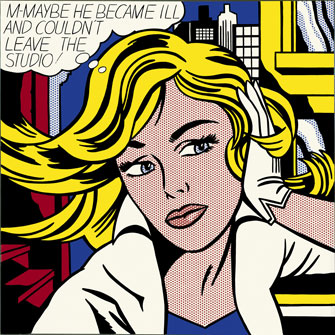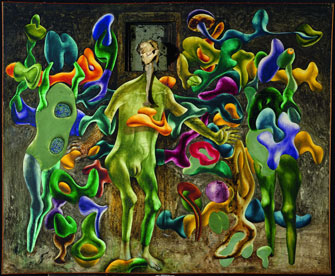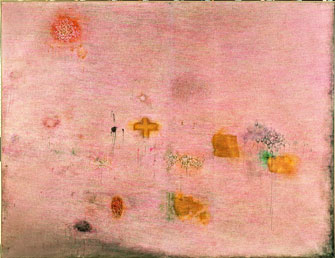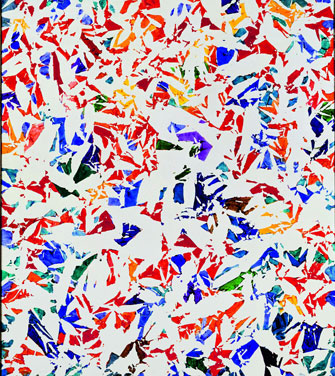Shared Detachment in
Separate but Parallel Careers

Lichtenstein’s “M-Maybe” (1965). © Estate of Roy Lichtenstein New York/ADAGP, Paris, 2013
The two major exhibitions currently showing at the Centre Pompidou are worth seeing together for the interesting comparison they provide between the career paths of two artists born a year apart from each other on opposite sides of the Atlantic: Simon Hantaï (1922-2008), a Hungarian who lived most of his adult life in Paris and became a French citizen in 1966, and his far more famous American contemporary Roy Lichtenstein (1923-97).
Early-20th-century American artists took their cues from the major European movements like Cubism and Surrealism, but the tide turned in the postwar world with the advent of Abstract Expressionism, which dominated the international art world for decades. Interestingly, Hantaï began his career by throwing his lot in with the Surrealists. He was championed by André Breton, but later broke with the pope of Surrealism, as did almost everyone associated with the movement. He then turned to American models like Jackson Pollock, although Matisse remained a major influence (especially obvious in such later works as the “Meuns” series from 1967-68).
Hantaï was a serious painter and, while I personally find his early Surrealist works – with their dingy colors and compositions teeming with animals, skulls and human bodies – unappealing, these minutely detailed works do show off his painterly skills. In the late 1950s, the artist started making gestural paintings using small strokes or handwriting to create abstract compositions. The influence of Pollock can be seen in pieces like “Peinture” (1958). Among the more striking works from



Three stages in Hantaï’s career: Top: “Femelle-Miroir II” (1953). Center: “Peinture (Écriture rose)” (1958-59). Bottom: “Blanc” (1974). All images © Adagp, Paris 2013
this period are the large-format “Peinture (Ecriture Rose)” and “À Galla Placidia” (1958-59), both built up from an accretion of small marks on the canvas.
Hantaï’s breakthrough came in the early 1960s when he came up with the idea of folding or crumpling canvases, painting on them and then flattening them out. He did many series of these “pliages,” which seem to show the influence of the Surrealists’ experiments with automatism. Hantaï gradually let brilliant color shine through in the pliages, leaving behind the dinginess of his earlier works, and the paintings became almost decorative. Among the loveliest are those in the monochrome “Etudes” series, with multiple shades of white and forms that seem to dance across the canvas, and the “Laissées” (“Leftovers”) series, which he cut out of earlier works.
Do take the time to watch the film (in French with no subtitles) of Hantaï at work in his studio, wrestling with his canvases, folding, knotting, flattening and painting them. While he compares himself to a housepainter, to the viewer he seems more like a magician as he lifts a huge, still-folded painting over his head and makes it comes to life as he stretches it from the inside.
The painter said that with these works he wanted to make painting mechanical, something that anyone could do, rendering the artist unnecessary, but in fact he was making artistic decisions all the time in the way he folded, knotted and painted the canvases and in his color choices. He did make the artist disappear, in a sense, when he began to withdraw from the art world in 1982 in protest against its speculative nature. He refused most offers of exhibitions and eventually stopped working. This is the first retrospective since 1976 of this European artist who so admired American art but never had a major show in the United States.
Lichtenstein, the other hand, was a pure product of American culture and profited handsomely from it. Pompidou’s retrospective of his work shows that he, like Hantaï, was a thinking man – the exhibition is full of interesting quotes from the Pop artist famous for his oversized interpretations of American comic books.
Lichtenstein, who was interested in the “energy and impact” of commercial art, used “supermarket colors” to create his highly graphic and simplified depictions of life in America. Aside from the seemingly straight-faced large-scale reproductions of comic book panels incorporating the dots that are part of the printing process, the show also includes his “Explosions,” painted in enamel on steel with the intention of making something “ephemeral completely concrete.”
His images of teary-eyed women and war scenes were painted in such a way as to drain the emotion from the subject matter, which did not interest him. What did interest him, he said, was “using highly charged material [in] a very removed, technical, almost engineering drawing style.” His cold, ironic detachment is often interpreted as a reaction to the emotional intensity of Abstract Expressionism.
Once Lichtenstein moved on from his celebrated comic-book paintings, as was inevitable, he never seemed to quite find a style that suited him, although he continued to use many of the same colors and techniques. Here we have some landscapes and still lifes and his takes on numerous paintings by such artists as Matisse (“Still Life with Goldfish,” 1972), Picasso and Mondrian. He also made glossy painted sculptures based on many of his own paintings.
Hantaï and Lichtenstein both seemed to be seeking detachment in their work. In his pliages, Hantaï tried to remove emotion from the equation and eventually removed himself from the picture, too, while Lichtenstein turned late in his career to a kind of detachment different from that in his comics-based paintings, making lovely, meditative works strongly influenced by Chinese painting.
Centre Pompidou: 19, rue Beaubourg, 75004 Paris. Tel.: 01 44 78 12 33. Open 11am-9pm. Closed Tuesday. Métro: Rambuteau. Admission: €11-13. Hantaï: through September 2, 2013. Lichtenstein: through www.centrepompidou.fr
Click here to read all of this week’s new articles on the Paris Update home page.
Reader reaction: Click here to respond to this article (your response may be published on this page and is subject to editing).
Please support Paris Update by ordering books from Paris Update’s Amazon store at no extra cost. Click on your preferred Amazon location: U.K., France, U.S.
More reviews of Paris art shows.
© 2013 Paris Update
Favorite